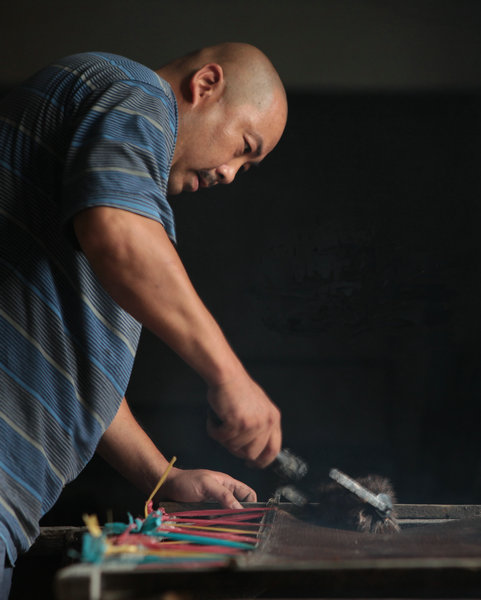
 |
|
Photo provided to China Daily |
Cheng Xiaochun says the secret to his craftsmanship is a modest lifestyle.
He makes sieve-like screens, or molds (zhilian in Chinese), which are crucial for creating traditional Chinese rice paper and other types of paper. It is a family business that Cheng became interested in while still in elementary school. Now 43 years old, Cheng was proclaimed a master at his craft in his mid-20s.
"Once your are rich you become lazy," Cheng tells China Daily. "Refrain from getting rich if you want to rely on your hands."
Masters of the trade-only a few remain in the country-are able to make paper by just looking at a piece. The making of Chinese rice paper typically involves more than 80 procedures. For example, if a stack of paper weighs some 2.5 kilograms, a refashioned bunch will deviate no more than 6 grams in weight.
The rice paper, or xuanzhi, which originated from Anhui province in the country's east, is the cornerstone of Chinese calligraphy and painting. Chinese artists are always keen to get well-cut rice paper. A proper cut (roughly 100 sheets) by machine could cost 1,000 yuan ($152) nowadays, while a coveted antique cut could go into tens of thousands of yuan.
Around 1,200 tons of rice paper are consumed each year in the country, according to China Publishing News.
A zhilian (138×138 centimeters) takes around a month to complete and could fetch from 20,000 to 30,000 yuan. A steady mold could sustain the making of 200,000 sheets of paper.
"I'd say it's mostly muscle memory, nothing too mystifying," Cheng says.
But it does require a few "skills".
Cheng says he is immune to Chinese lacquer, an ingredient for making molds that chafes the skin, and he is less enthusiastic about cutting corners.
"I was introduced to the family business the traditional way. I started from the most tiresome, elementary jobs like scrubbing the place clean," he recalls. "If I got distracted for a second, my grandfather would not hesitate to give me a beating."
It is no longer the case for his own apprentices.
"You can't force young people to go through that hardship now," he says, adding that theories seem to play a greater role in mentoring than practices these days.
With new ways of teaching, Cheng says he cannot tell where the art is headed.
The mold-making business is 300 years old. But the industry peaked in the 1960s, when many artisans from different trades came to Cheng's hometown in Zhejiang province's Quzhou city and settled down to assist the paper industry. Cheng's family had migrated from Anhui much earlier.
 |
|
Cheng Xiaochun (left) and his father work on a mold for making rice paper. The family has carried on the traditional craftsmanship for generations.[Photo provided to China Daily] |
"These people were not born into the business, but they excelled because they already had an impeccable understanding of the essential spirit of craftsmanship," Cheng says of the olden-day artisans.
Their history of migration, social problems and a lifestyle that's slowly fading are all part of Cheng's narrative today. Other than being a government-recognized master craftsman, Cheng is a grower of Chinese herbs and a tai chi practitioner. The artisan life aside, Cheng still keeps his day job at a local urea factory.
"It will give me security if things look down," Cheng says. "It also allows me to choose the zhilian-making jobs I want."
He does not accept offers to make "very bad or very good" paper as he says it is "impossible" to make paper like it used to be made in the past in China.
For example, long wang xuan ("dragon king" paper), a piece of royal rice paper that reportedly spans more than 40 meters in length, is one of the many ancient pieces of paper people nowadays hope to re-create.
"History books say it took more than 100 craftsmen working in sync. It's the result of a whole nation's efforts. How can it be re-created now by me alone?"
That said, Cheng's plan for the coming years until his retirement is reviving lost paper. His father retired at age 70, when his eyesight-a crucial faculty for the craft-failed him.
"I can't tell what people after me would do with them, but I hope to leave them with some samples, like paper made of silk ... that no longer exist.
"Paper-making, as any other trade, is constantly changing and evolving," he says. "After all, it's made for use. So it's natural for one thing to die out and another to come into fashion.
"That's why I don't have a favorite paper or mold. Each one is special, functional in its own time."
Cheng's understanding of his trade is presented in The Lacing of Life, the first installment of a three-part, award-winning documentary on the art of making molds.
"There is a reason why workshops and apprentice-style handicrafts are longstanding," says Lei Jianjun, the film's director and an associate professor at Tsinghua University.
Factories seldom produce the same results, he says.

Presented by Chinadaily.com.cn Registration Number: 10023870-7
Copyright © Ministry of Culture, P.R.China. All rights reserved